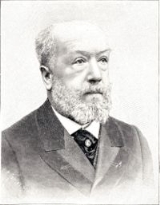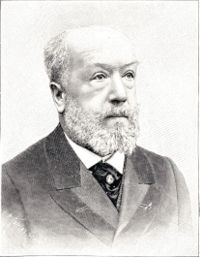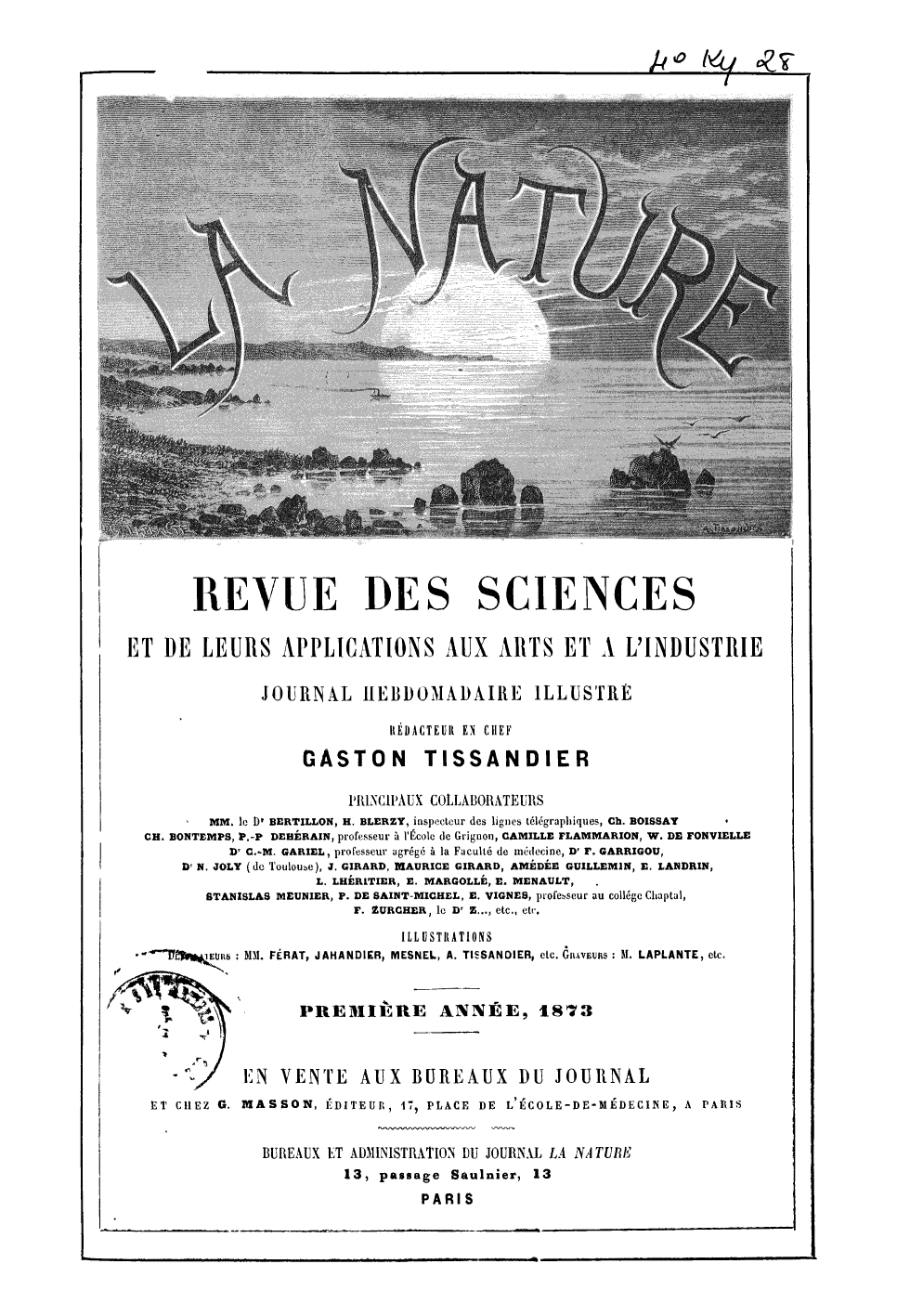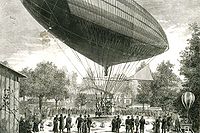
Albert Tissandier
Encyclopedia


France
The French Republic , The French Republic , The French Republic , (commonly known as France , is a unitary semi-presidential republic in Western Europe with several overseas territories and islands located on other continents and in the Indian, Pacific, and Atlantic oceans. Metropolitan France...
architect
Architect
An architect is a person trained in the planning, design and oversight of the construction of buildings. To practice architecture means to offer or render services in connection with the design and construction of a building, or group of buildings and the space within the site surrounding the...
, aviator
Aviator
An aviator is a person who flies an aircraft. The first recorded use of the term was in 1887, as a variation of 'aviation', from the Latin avis , coined in 1863 by G. de la Landelle in Aviation Ou Navigation Aérienne...
, illustrator
Illustrator
An Illustrator is a narrative artist who specializes in enhancing writing by providing a visual representation that corresponds to the content of the associated text...
, editor
Editing
Editing is the process of selecting and preparing written, visual, audible, and film media used to convey information through the processes of correction, condensation, organization, and other modifications performed with an intention of producing a correct, consistent, accurate, and complete...
and archaeologist. He was the brother of adventurer Gaston Tissandier
Gaston Tissandier
Gaston Tissandier was a French chemist, meteorologist, aviator and editor. Adventurer could be added to the list of his titles, as he managed to escape besieged Paris by balloon in September 1870. He founded and edited the scientific magazine La Nature and wrote several books.His brother was...
with whom he collaborated in writing the magazine La Nature
La Nature
La Nature was a French language magazine aimed at the popularization of science founded in 1873 by French scientist and adventurer Gaston Tissandier...
, a French language
French language
French is a Romance language spoken as a first language in France, the Romandy region in Switzerland, Wallonia and Brussels in Belgium, Monaco, the regions of Quebec and Acadia in Canada, and by various communities elsewhere. Second-language speakers of French are distributed throughout many parts...
scientific journal
Scientific journal
In academic publishing, a scientific journal is a periodical publication intended to further the progress of science, usually by reporting new research. There are thousands of scientific journals in publication, and many more have been published at various points in the past...
aimed at the popularization of science
Popular science
Popular science, sometimes called literature of science, is interpretation of science intended for a general audience. While science journalism focuses on recent scientific developments, popular science is broad-ranging, often written by scientists as well as journalists, and is presented in many...
. He and his brother demonstrated the first electric powered flight.
Early years and La Nature
Born in ParisParis
Paris is the capital and largest city in France, situated on the river Seine, in northern France, at the heart of the Île-de-France region...
in 1839, Albert Tissandier was a loyal and assiduous companion of his brother, Gaston Tissandier
Gaston Tissandier
Gaston Tissandier was a French chemist, meteorologist, aviator and editor. Adventurer could be added to the list of his titles, as he managed to escape besieged Paris by balloon in September 1870. He founded and edited the scientific magazine La Nature and wrote several books.His brother was...
. A distinguished architect, he was involved in a large number of projects.
Though his brother was nominally the sole founder of La Nature, a scientific journal
Scientific journal
In academic publishing, a scientific journal is a periodical publication intended to further the progress of science, usually by reporting new research. There are thousands of scientific journals in publication, and many more have been published at various points in the past...
aimed at the popularization of science, Albert contributed extensively to the magazine, mostly as an illustrator
Illustrator
An Illustrator is a narrative artist who specializes in enhancing writing by providing a visual representation that corresponds to the content of the associated text...
and editor. He was heavily involved in it from the very first issue in 1873 until his retirement in 1905, less than a year before his death.
Aviation career
His devotion to aeronauticsAeronautics
Aeronautics is the science involved with the study, design, and manufacturing of airflight-capable machines, or the techniques of operating aircraft and rocketry within the atmosphere...
began on 8 November 1868, when he made his first hot air balloon
Hot air balloon
The hot air balloon is the oldest successful human-carrying flight technology. It is in a class of aircraft known as balloon aircraft. On November 21, 1783, in Paris, France, the first untethered manned flight was made by Jean-François Pilâtre de Rozier and François Laurent d'Arlandes in a hot air...
ascent between Melun
Melun
Melun is a commune in the Seine-et-Marne department in the Île-de-France region in north-central France. Located in the south-eastern suburbs of Paris, Melun is the capital of the department, as the seat of an arrondissement...
and Paris during a snowstorm.
During the siege of Paris
Siege of Paris
The Siege of Paris, lasting from September 19, 1870 – January 28, 1871, and the consequent capture of the city by Prussian forces led to French defeat in the Franco-Prussian War and the establishment of the German Empire as well as the Paris Commune....
in the Franco-Prussian war
Franco-Prussian War
The Franco-Prussian War or Franco-German War, often referred to in France as the 1870 War was a conflict between the Second French Empire and the Kingdom of Prussia. Prussia was aided by the North German Confederation, of which it was a member, and the South German states of Baden, Württemberg and...
, Albert Tissandier piloted one of the first mail balloons to outside the city. He escaped Paris on 14 October 1870, in the gondola of the balloon Jean-Bart, taking two other travellers in his care. Additionally, he carried 400 kg (1000 lb) of mail and dispatches from 100 anxious families. He was awarded the Médaille militaire
Médaille militaire
The Médaille militaire is a decoration of the French Republic which was first instituted in 1852.-History:The creator of the médaille was the emperor Napoléon III, who may have taken his inspiration in a medal issued by his father, Louis Bonaparte, King of Holland...
for his bravery.

The Zénith
A few years later, the two brothers ascended in another hot air balloonHot air balloon
The hot air balloon is the oldest successful human-carrying flight technology. It is in a class of aircraft known as balloon aircraft. On November 21, 1783, in Paris, France, the first untethered manned flight was made by Jean-François Pilâtre de Rozier and François Laurent d'Arlandes in a hot air...
, this one called the Zénith. On 23 March and 24 March 1875 they flew from Paris to Arcachon
Arcachon
Arcachon is a commune in the Gironde department in southwestern France.It is a popular bathing location on the Atlantic coast southwest of Bordeaux in the Landes forest...
, on the other side of the country, near Bordeaux
Bordeaux
Bordeaux is a port city on the Garonne River in the Gironde department in southwestern France.The Bordeaux-Arcachon-Libourne metropolitan area, has a population of 1,010,000 and constitutes the sixth-largest urban area in France. It is the capital of the Aquitaine region, as well as the prefecture...
, a total distance of 600 km (400 mi). During this ascent, he drew the countrysides below as naturally as possible. He also observed that when the moon passed above the clouds, the upper surface of the clouds shimmered like a lake, and recorded this in a drawing (right).
Only a few days after this ascent, on 15 April at 11:35 AM, the Zénith went up again, this time with only Gaston Tissandier, Joseph Croce-Spinelli and Théodore Sivel with the goal of reaching an extreme height in order to continue their observations. They were able to reach the unheard of altitude of 8,600 m (28,000 ft). The latter became victims of their devotion to science dying from asphyxiation from the thin air. Gaston Tissandier himself became deaf and struggled with the problem for the rest of his life.
First electric powered flight

Electric motor
An electric motor converts electrical energy into mechanical energy.Most electric motors operate through the interaction of magnetic fields and current-carrying conductors to generate force...
to a dirigible. It was after their first experiences with flight that they made the large model they demonstrated, for which Albert drew the blueprints. The first flight of an electric dirigible aerostat
Aerostat
An aerostat is a craft that remains aloft primarily through the use of buoyant lighter than air gases, which impart lift to a vehicle with nearly the same overall density as air. Aerostats include free balloons, airships, and moored balloons...
took place on 8 October 1883. They made a second attempt on 26 September 1884 which gave them all the results they were looking for.
Archaeology and travels
Albert Tissandier was also a passionate writer and traveller. In 1886 he started a long trip around the world in AmericaAmericas
The Americas, or America , are lands in the Western hemisphere, also known as the New World. In English, the plural form the Americas is often used to refer to the landmasses of North America and South America with their associated islands and regions, while the singular form America is primarily...
, subsequently travelling to the East Indies
East Indies
East Indies is a term used by Europeans from the 16th century onwards to identify what is now known as Indian subcontinent or South Asia, Southeastern Asia, and the islands of Oceania, including the Malay Archipelago and the Philippines...
, Ceylon and many other Asia
Asia
Asia is the world's largest and most populous continent, located primarily in the eastern and northern hemispheres. It covers 8.7% of the Earth's total surface area and with approximately 3.879 billion people, it hosts 60% of the world's current human population...
n locales, sending his magnificent illustrations back to Paris so they could appear in La Nature
La Nature
La Nature was a French language magazine aimed at the popularization of science founded in 1873 by French scientist and adventurer Gaston Tissandier...
.
In January 1890, he was by the Minister of Public Instruction and Fine Arts on an archaeological
Archaeology
Archaeology, or archeology , is the study of human society, primarily through the recovery and analysis of the material culture and environmental data that they have left behind, which includes artifacts, architecture, biofacts and cultural landscapes...
mission to India
India
India , officially the Republic of India , is a country in South Asia. It is the seventh-largest country by geographical area, the second-most populous country with over 1.2 billion people, and the most populous democracy in the world...
, China
China
Chinese civilization may refer to:* China for more general discussion of the country.* Chinese culture* Greater China, the transnational community of ethnic Chinese.* History of China* Sinosphere, the area historically affected by Chinese culture...
and Japan
Japan
Japan is an island nation in East Asia. Located in the Pacific Ocean, it lies to the east of the Sea of Japan, China, North Korea, South Korea and Russia, stretching from the Sea of Okhotsk in the north to the East China Sea and Taiwan in the south...
. These travels occupied him for two years, and he gave a complete account of his travels, including remarkably exact and beautiful illustrations.
In 1893 and 1894, he visited Cambodia
Cambodia
Cambodia , officially known as the Kingdom of Cambodia, is a country located in the southern portion of the Indochina Peninsula in Southeast Asia...
and Java
Java
Java is an island of Indonesia. With a population of 135 million , it is the world's most populous island, and one of the most densely populated regions in the world. It is home to 60% of Indonesia's population. The Indonesian capital city, Jakarta, is in west Java...
including all the Khmer
Khmer people
Khmer people are the predominant ethnic group in Cambodia, accounting for approximately 90% of the 14.8 million people in the country. They speak the Khmer language, which is part of the larger Mon–Khmer language family found throughout Southeast Asia...
and Javanese ruins. Like his previous trip, he kept a record of precise and detailed illustrations and a large amount of remarkable artifacts
Artifact (archaeology)
An artifact or artefact is "something made or given shape by man, such as a tool or a work of art, esp an object of archaeological interest"...
.
Retirement and death
Following his travels, he at last returned to Paris and continued working extensively on La NatureLa Nature
La Nature was a French language magazine aimed at the popularization of science founded in 1873 by French scientist and adventurer Gaston Tissandier...
. Though his brother Gaston died on 30 August 1899, he continued to be a large contributor to and editor
Editing
Editing is the process of selecting and preparing written, visual, audible, and film media used to convey information through the processes of correction, condensation, organization, and other modifications performed with an intention of producing a correct, consistent, accurate, and complete...
of the magazine. He retired in 1905, dying on 5 September 1906 at Jurançon
Jurançon
Jurançon is a commune in the Pyrénées-Atlantiques department in south-western France.-See also:*Jurançon AOC, a wine from this commune*Communes of the Pyrénées-Atlantiques department-References:*...
. Many believed that the magazine would not be able to continue after his death.
External links
- Gaston et Albert Tissandier
- Tissandier Collection from the Library of Congress. Drawings, prints, and photographs by and collected by Gaston and Albert Tissandier.

